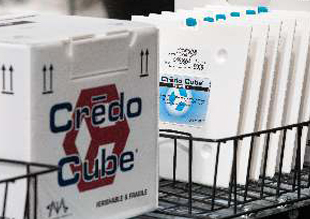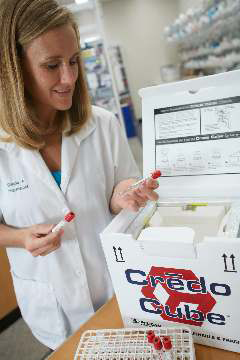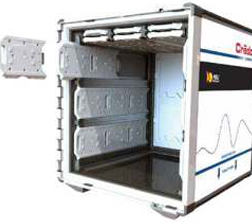Pelican BioThermal touts power of temperature controlled packaging in pharmaceutical industry
The global pharmaceuticals market was worth $934.8 billion in 2017 and will reach $1170 billion in 2021, growing at 5.8%, according to a recent pharma market research report by The Business Research Company.
Packaging in the pharmaceutical industry plays a pivotal role to protect them against harmful impact of external forces like light, gases or moisture while being transported to their final destinations. Labeling and packaging are
equally important to keep their health benefits.
The global pharmaceuticals market was worth $934.8 billion in 2017 and will reach $1170 billion in 2021, growing at 5.8%, according to a recent pharma market research report by The Business Research Company.
This is an accelerated pace compared to 5.2% for the years before 2017, but is slower than the other two large healthcare segments, medical equipment and healthcare services. Healthcare as a whole is growing at over 7% year-on-year.
Thermal packaging is the preferred method for pharmaceuticals because they require a defined temperature to be maintained during transportation.
The development and widespread availability of specialized insulated packaging materials has enabled consumer goods manufacturers to expand their business beyond their local areas, and to outof- state and overseas customers.
Pelican BioThermal is the first cold chain packaging solutions provider to make available a broad and diverse portfolio of single use and reusable passive temperature controlled packaging for the pharmaceutical industry.
 “In order to have very good control of the temperature inside the packaging space, we have a lot of engineering investment, in design of the materials in both the insulators and the phase change materials that are then tuned to meet the requirements of those very strict temperature bands, it takes a lot of effort and resources to
“In order to have very good control of the temperature inside the packaging space, we have a lot of engineering investment, in design of the materials in both the insulators and the phase change materials that are then tuned to meet the requirements of those very strict temperature bands, it takes a lot of effort and resources to
be able to do that.”
Paul Terry, Pelican BioThermal, Sales Director-EMEA
Paul Terry, Pelican BioThermal, Sales Director-EMEA, explains in an email interview how their thermal packaging offers a sustainable low cost and safe packaging for pharmaceuticals.
Insulating thermal packaging
Thermal insulation packaging is normally manufactured with the following materials: Sheets made of synthetic foams—polyurethane, or natural fibers, such as recycled cotton, natural cellulose or paper fibers and reflective
materials – also referred to as metalized, mylar or silver films – which are
actually polymer films with a thin layer of aluminum.
Peli BioThermal is the supplier of isolated thermal packaging which allows clients to ship products in parcels of all different shapes and sizes whilst maintaining an environment within that package of a strict temperature
range. That space within the package is therefore controlled in terms of temperature, the very essence of thermal isolated packaging.
“We combine two major aspects to create our solutions. One is the insulation of thermal isolated packaging. All of our systems would have a degree of insulative material which forms the outer part of the box. That’s intended to
isolate the internal space from the external environment and therefore help maintain a more consistent temperature inside the packaging space over the duration of use,” Terry explained.
“Insulation on its own has only very limited performance so we combine those insulators with coolant cells which exploit the latent power that comes from materials change phase from liquid to solid. The energy that is stored or
released in that process of changing phase between solid and liquid is used to maintain the environment inside our packaging solutions at the desired
temperature range.”
Secure means of maintaining thermal environment Pharmaceutical products require special care and transport solutions when being transported to keep their health benefits.
Terry said there are different ways to do this but thermal isolated packaging has the advantage because it provides a more efficient and often more secure means of maintaining the right thermal environment while shipping the
product.
“We use high quality phase change liquids and very efficient insulators which allows our clients to ship products without needed to deploy mobile refrigeration or additional supply chain infrastructure along their supply chain,” he said.
According to Terry, the control point where pharmaceutical client dispatches their goods is the point where Pelican BioThermal establish the control and temperature of the environment in the packaging system. Those initial conditions are then maintained throughout the product’s journey by the packaging elements without any other active support or intervention. It is self-contained and self-regulated.
“So, you can have a lot of control at the start point where you have hands on the pharmaceutical product and as your product flows through the supply chain where you have potentially many different partners handing off that parcel from one to another. The control of the temperature that you initially set with our system carries through the entire supply chain eliminating any breaks in what we call the cold chain of custody of the product despite many handling partners being involved.”
The Pelican BioThermal systems are very safe: they don’t have power failures and are set up with the correct controls at the start, the business executive noted.
Adding, that control level follows the product and maintains the product at the right temperature through its storage and therefore maintains and maximizes the efficacy of that product for when it eventually reaches a patient or its end use.
In terms of sustainability and low cost, the industry is now moving very rapidly towards more reusable containers, where they get a lot of efficiency because of the systems such as Credo, provide shelf lives that have been proven to exceed 5 years allowing for many uses. Over that length of lifecycle, the material impact on the environment is very low and even then, the spent system can be recaptured, recycled and reused beyond that point through the service network.
“When you reuse the packaging systems the cost per use also drops dramatically. So, although the initial outlay might look reasonably high, as an investment over its lifecycle the per shipping cost is very reasonable. In term of the high initial cost there are ways you can utilize the system on a per use bases under our Crēdo™ On
Reserve program. Rather than having to invest upfront in the packaging systems you are now able to lease or hire them on a per use basis over the term of your
requirement.
“Reuse is therefore a very effective way of being both low cost and sustainable and because you are in a low-cost environment you can also afford to deploy more sophisticated packaging systems which have more performance and more safety as well. So, it is a three-way win when you get into the world of reuse when executed properly”.
Maintaining temperature
The temperature maintained in the thermal packaging boxes are at a very strict range. So typically, 2 – 8C degrees or 15 – 25C or sub minus 20C degrees are very common ranges, according to Terry.
However, out of which, 2 – 8C is the most common because when initial pharmaceutical compounds are developed, it comes to clinical trial products, clients are likely not to have stability data for their product of active compounds outside of that temperature range so 2 – 8C common for clinical studies.
But when you are dealing with more commercially produced compounds there is a definition of controlled room temperature which commonly is 15 -25C degrees.
“In order to have very good control of the temperature inside the packaging space, we have a lot of engineering investment, in design of the materials in both the insulators and the phase change materials that are then tuned to meet the requirements of those very strict temperature bands, it takes a lot of effort and resources to be able to do that.
“It is really only the pharmaceutical industry that requires those stringent temperature bands for their products. This is because of the high nature of the value of pharmaceutical products and the additional costs if products are
damaged in shipping by going outside of set temperature range
resulting in loss of their efficacy.
This can obviously impact very negatively on end user patients.” Terry also notes there is an increasing interest in frozen especially with the growth of b i o l o g i c s a n d a c t i v e pharmaceutical ingredients where
they are shipped frozen. Minus 20C is a growing area as is -50C as a requirement.
There is a move away from dry ice (around -74C) which has alsobeen used traditionally to ship frozen products because it is very cost effective. However, there are issues with dry ice as it creates carbon dioxide which is not necessarily a great thing to have in abundance in a closed aircraft or warehouse environment and in
some cases the temperature is too cold for the product.
The industry arguably started to deploy reuse for economic benefit but sustainability is now far higher on the company’s agenda of their client base than it has been in the past and the reuse of high quality, high performance systems really fits to that agenda of sustainability and protecting the environment. That is where the Credo brand products really deliver client value, according to Peli.
 “We work closely with our clients. We have very technically capable sales people who really understand how our products work and they are also supported by a very well invested technical team of thermal engineers and a world leading facility of thermal chambers for testing and qualifying products. All of our products are capable of being trusted in the highly regulated pharma market. We make sure all our efforts go into the very robust qualification of our systems. We can now demonstrate how our products will perform every time in the market within most environments that the packaging will experience over the time duration.
“We work closely with our clients. We have very technically capable sales people who really understand how our products work and they are also supported by a very well invested technical team of thermal engineers and a world leading facility of thermal chambers for testing and qualifying products. All of our products are capable of being trusted in the highly regulated pharma market. We make sure all our efforts go into the very robust qualification of our systems. We can now demonstrate how our products will perform every time in the market within most environments that the packaging will experience over the time duration.
“Typically we will test our systems to high stress and over long durations and our clients will tend to use the product with that performance envelop so they can be reassured they are getting as near to 100% success as you can in terms of performance of the shipment every time.”
How packaging and technology go hand in hand?
It is a question of performance versus price. There are protective systems in the market that give minimal protection, Pelican BioThermal have thermal covers which are basic form of solar protection for any product left in the sun or experience some short period of cold or hot environments for a limited period.
They can give a reasonable protection over a wide temperature range for up to eight hours.
But if the client is looking for a more stringent defined temperature shipping range and wants to extend that duration into hours, days, or even weeks, then they need to look at highly qualified materials and more engineered systems. There is a scale of performance for price, the more performance they need the more cost there is in those materials and the higher the price but then reuse allows them to deploy that on a by shipment basis at a very reasonable rate.
The packaging they select is a combination of the duration they need and how strict they need the temperature controlled.
“Move to reuse is accelerating month by month and is an area we at Peli have been operating in for well over 10 years and are well established in, so it is great that demand for reuse is growing.
“The other trend is for high technology products, driven by people looking to save money in their total cost of ownership. The transportation costs are a really significant part of the piece, so if you can reduce your transportation expenses you can easily justify spending a little bit more on the packaging to enable you to unlock those savings further down the supply chain.”
According to Peli, seeking better performance is also an area of focus. The company has the ability to almost eliminate temperature excursions in shipments with clients who may have seen +25% of their shipments going outside of temperature range before they started using our Credo Cube or Chronos Advance (now called CoolGuard Advance) products.
There is a middle ground in terms of products which are ‘semi’ reusable in a sense that their main components can be recovered, inspected and reused. That is an area Peli is now supporting. Recovering the valuable components to their systems and then redeploying them back into a newly configured system for reuse.
“Our newly rebranded CoolGuard™ and CoolPall™ ranges can be deployed using this methodology helping reduce environmental waste and reducing supply chain costs for our clients,” Terry concludes our email interview.












